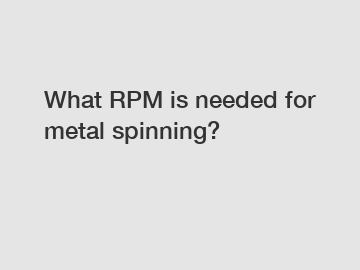What RPM is needed for metal spinning?
What RPM is needed for metal spinning? When it comes to metal spinning, one of the crucial factors to consider is the rotational speed or RPM (Revolutions Per Minute) at which the metal is spun. The required RPM for metal spinning varies depending on several factors, including the material being spun, the size and complexity of the object being formed, and the desired outcome. .
To determine the ideal RPM for metal spinning, one must take into account the material's ductility and the desired thickness of the spun metal. Ductility refers to a material's ability to deform under tensile stress, and it plays a significant role in metal spinning. Different materials have different ductility levels, and this affects the optimal RPM required.
For softer and more ductile materials like aluminum or copper, a lower RPM is generally recommended. This is because these materials can be easily deformed at lower rotational speeds, allowing for precise control over the shaping process and minimizing the risk of material tearing or wrinkling. In such cases, RPM ranging from 500 to 1500 is commonly used. This range ensures that the metal gradually takes the desired shape without any excessive stretching or distortion.

On the other hand, harder and less ductile materials like stainless steel or titanium require higher RPM. These materials have higher tensile strength and are more resistant to deformation. A higher RPM helps generate the necessary centrifugal force to overcome their resistance, allowing for effective shaping. Typically, RPM between 1500 and 3000 is suggested for spinning harder metals.
Determining the appropriate RPM for metal spinning goes beyond the material properties alone. The size and complexity of the object being formed also play a critical role. Larger and more intricate shapes often require lower RPM because higher speeds can result in uneven distribution of metal thickness or cause excessive vibrations. Smaller and simpler shapes, on the other hand, can be spun at higher RPM without compromising the final outcome.
The importance of selecting the right RPM in metal spinning cannot be overstated. Using an incorrect RPM can lead to various issues such as overstretching or tearing of the material, uneven thickness distribution, or surface imperfections. These issues not only affect the quality of the final product but also increase the likelihood of material waste and the need for rework.
In conclusion, the RPM needed for metal spinning depends on the material's ductility, the desired thickness, and the size and complexity of the object being formed. Softer and more ductile materials benefit from a lower RPM, while harder and less ductile materials require higher RPM. Selecting the appropriate RPM is crucial to ensure precise shaping, minimize material waste, and achieve high-quality metal spun products.
Contact us to discuss your requirements of metal spinning machine manufacturers, Metal Flow Forming Machine For Sale, Metal Spinning Machine. Our experienced sales team can help you identify the options that best suit your needs.


